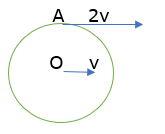A hoop of radius 2 m weighs 100 kg. It rolls along a horizontal floor so that its centre of mass has a speed of 20 cm/s. How much work has to be done to stop it?
What we want to find is work done. We know that the work done to stop a moving body is the total kinetic energy of the body.
∴ Work Done = KE = KErot + KEtran
Where KErot is rotational kinetic energy and
KEtran is translational kinetic energy
KErot = 1/2 Iω2
KEtran = 1/2 Mv2
Where M is mass of hoop
I is moment of inertia of hoop
v is velocity of centre of mass
ω is angular velocity
Now the given values are,
Mass of hoop, M = 100 Kg
Radius of hoop, R = 2 m
Speed of centre of mass of hoop, v = 20 Cm s-1
= .2 m s-1
The axis of rotation of hoop passes through point B, we know that velocity of point O (centre of loop) is v. If ω is angular velocity of hoop then,
v = R ω (R is Distance between axis and centre(O))

Where ω is angular velocity.
i.e. ω = v/R = 0.2/2 = .1 s-1
Moment of inertia of hoop, I = MR2
Where, M is mass of hoop
R is Radius of hoop
∴ I = 100(2)2
I = 400 Kg m2
Total Kinetic Energy of hoop,
KE = KErot + KEtran
KErot = 1/2 400 × (.1)2
= 2 J
KEtran = 1/2 100 × (.2)2
= 2 J
∴ Total Kinetic energy,
KE = 2 + 2 = 4 J
Work done to stop the moving hoop is equal to its KE which is 4 J